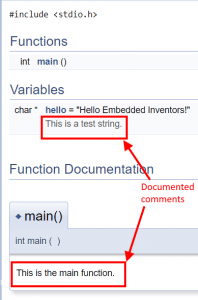

The OutlineParserInterface is used to collect information about the symbols that can be documented but does not look into the body of functions. Each parser implements two abstract interfaces: OutlineParserInterface en CodeParserInterface. These functions use the ParserManager singleton factory to create a suitable parser object for each file. The function parseFilesSingleThreading() takes care of parsing all files (in case NUM_PROC_THREADS!=1, the function parseFilesMultiThreading() is used instead). The script configgen.py will also create the documentation for the configuration items, creating the file config.doc.Īfter the configuration is known, the input files are searched using searchInputFiles() and any tag files are read using readTagFile() As part of the build process, the python script configgen.py will create the files configoptions.cpp, configvalues.h and configvalues.cpp from this, which serves as the input for the configuration file parser that is invoked using Config::parse(). The format of the configuration file (options and types) is defined by the file config.xml. The generic starting point of the application is of course the main() function.Ĭonfiguration file data is stored in singleton class Config and can be accessed using wrapper macros Config_getString(), Config_getInt(), Config_getList(), Config_getEnum(), and Config_getBool() depending on the type of the option. Users of doxygen are referred to the User Manual. This document is intended for developers who want to work on doxygen. We can be reached via the comments below or in email at You can also find our team on Twitter at VisualC.This page provides a high-level overview of the internals of doxygen, with links to the relevant parts of the code.
#Doxygen comments update
You can also join our Insiders program and get access to early builds of our release by going to File > Preferences > Settings and under Extensions > C/C++, change the “ C_Cpp: Update Channel” to “ Insiders”. If you run into any issues, or have any suggestions, please report them in the Issues section of our GitHub repository.
#Doxygen comments code
$TICK Tick count (from Windows GetTickCount) Additional enhancementsĪnother enhancement with the July 2020 update is if you use a member selection operator on a pointer type, the C++ extension now shows suggestions for corresponding members and automatically converts ‘.’ to ‘->’ ( #862).ĭownload the C++ extension for Visual Studio Code today, give it a try, and let us know what you think. You can also print the following $TOKENS in Logpoint messages: Any expression between curly braces (‘’) will be evaluated when the Logpoint hits. Then select Add Logpoint and type the message you want to log. To add a Logpoint, right click in the far-left margin next to a line of code. With the July 2020 update, the C++ extension now supports Logpoints for GDB and LLDB. Logpoints are like breakpoints, though, in the sense that they are not part of the source code. When your program hits a Logpoint, it will print its contents to the debug console and continue running it doesn’t stop executing as it would for a breakpoint. Logpoints (also known as Tracepoints in Visual Studio) allow you to add on-demand logging statements into your application. If you’ve ever used print statements to debug your code, Logpoints will make your life a whole lot easier. If you call TriangleArea, for example, the following documentation will pop up with information about its parameters: You’ll also see documentation while typing, such as when you’re calling a function.

Then when you hover over TriangleArea in your code, you’ll see the corresponding documentation: With the July 2020 update, Visual Studio Code supports the visualization of Doxygen comments when hovering over a function and while typing.įor example, if you have the following Doxygen comment above your TriangleArea function declaration: You can annotate your code with comments that contain helpful tips about functions, then Doxygen will generate documentation from these comments. Displaying Doxygen Commentsĭoxygen is a programming tool that generates documentation for source code.

To find out more about all the changes, check out our release notes on GitHub. This latest release offers brand new features, such as the visualization of Doxygen comments and support for Logpoints while debugging (GDB/LLDB), along with a bunch of enhancements and bug fixes. The July 2020 update of the Visual Studio Code C++ extension is now available.


 0 kommentar(er)
0 kommentar(er)
